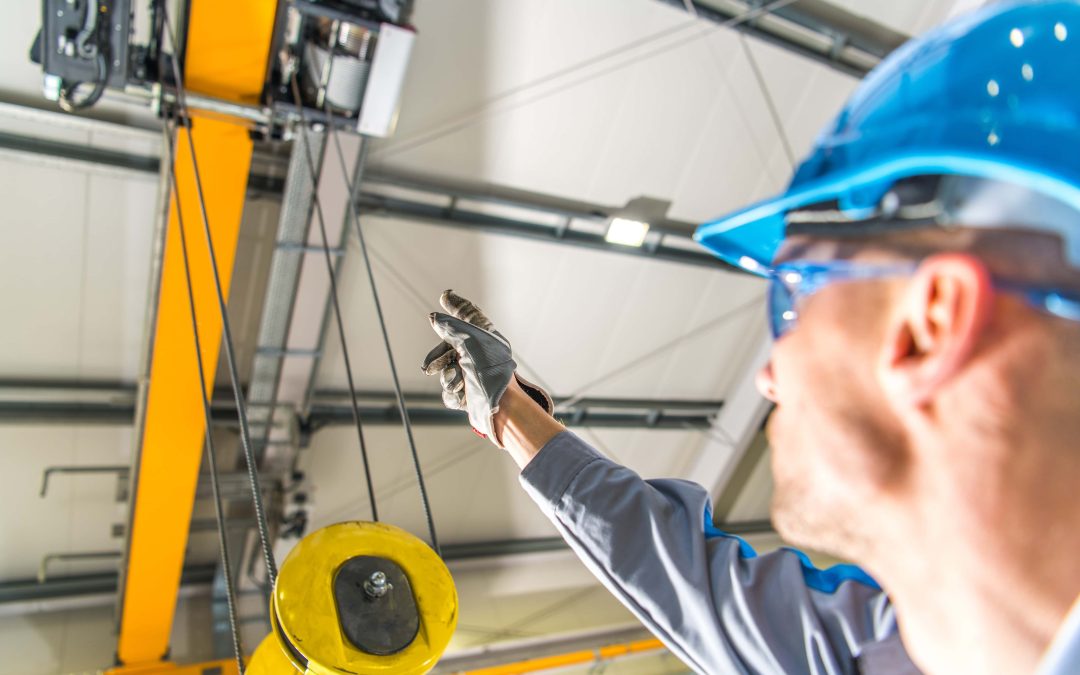
Overhead lifting systems work within a specific area to limit potential risks posed to employees and bystanders. Doing so allows lifting equipment to operate as efficiently as possible without affecting your facility’s safety levels.
Properly implemented overhead lifting systems allow product to be transported safely. Have you considered the costs related to OSHA citations, increased workers’ comp rates, potential lawsuits, medical expenses, and the temporary or permanent replacement of an injured employee? These issues cost employers billions of dollars annually. This makes investing in the safest lifting and moving systems more than just ideal—doing so is a practical, cost-saving proposition.
Inspection Requirements for Overhead Cranes and Parts
Overhead Crane Requirements
Routine inspections are required to guarantee continued safe operation of overhead cranes because of the size and weight of the objects they regularly lift and transport overhead. Whether a crane is new or altered, an initial inspection is necessary before it can be used.
Once overhead cranes are placed into service, they require two unique types of inspections:
- Frequent inspections, which occur daily to monthly
- Periodic inspections, which are completed 1–12 times per year
These types of inspection are intended to examine key components of the crane. This helps to determine the extent of malfunction, deterioration, or wear and tear on the crane’s components.
Items that Need Inspection and Their Frequency
The following items require daily inspection:
- Functional operating mechanisms: These systems must be checked for maladjustment
- Hydraulic and air system components: Valves, lines, tanks, drain pumps, and other components must be checked for deterioration or deficiency
- Crane hooks: These must be checked for cracks or deformation
There are also several features that require monthly inspections or other actions:
- Rope and end connections: These must be run to check for broken strands or wear every month
- Hoist chains and end connections: These must be checked for distortion, twit, excessive wear, or anything else that may interfere with their proper function or cause them to stretch beyond their manufacturer’s recommendations
- Written records: All records must be carefully updated with each inspection that is performed
Other inspections are performed on an as needed basis. Test functional operating mechanisms for excessive wear regularly. This may be daily or monthly depending on the amount of use your crane system gets. Rope reeving inspections should be completed as needed or recommended per the manufacturer’s instructions.
Maintenance and Design Requirements
Design Requirements
OSHA specifies a number of design requirements pertaining to the construction of the crane’s cab and its controls. OSHA also outlines many regulations that govern the cab’s lighting, footwalks, ladders, and stairways. OSHA recommendations additionally cover the following components:
- Bridge and trolley bumpers
- Hoist, holding, trolley, and bridge brakes
- Electrical components
- Hoisting equipment
- Warning devices
Maintenance Requirements
You must implement a preventative maintenance program according to the recommendations of the crane manufacturer. If you detect any unsafe conditions or deteriorated components during your required inspections, you must complete maintenance before you can use the crane again.
Only designated personnel are allowed to perform the necessary repairs and maintenance. The requirements of 29 CFR 1910.147, the control of hazardous energy or tagout/lockout, should be used to de-energize the crane.
Learn More About American Crane’s Lifting Solutions
Maintaining effective overhead crane safety practices is crucial for preserving equipment and employee safety. American Crane builds a wide range of lifting devices designed to comply with OSHA regulations and maximize safety on your production floor.
To learn more about how to ensure your critical lifts comply with the strictest safety standards, download our free eBook, “No Room for Error: A Guide to Critical Lift.” If you would like to learn more about American Crane’s services and capabilities, don’t hesitate to contact us today.


